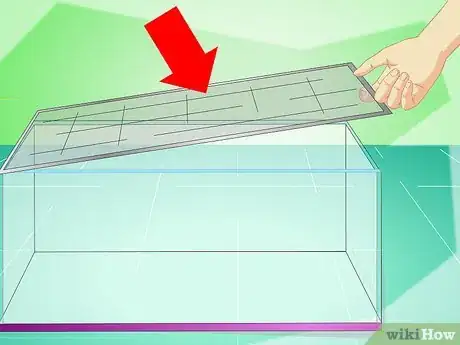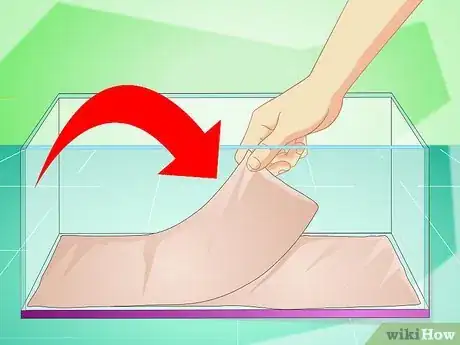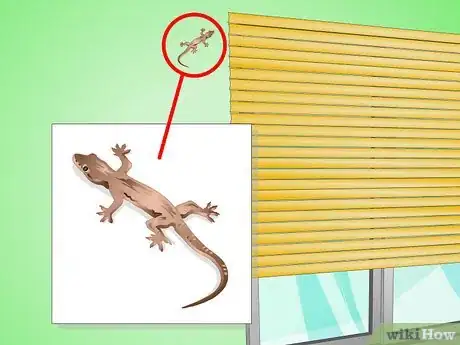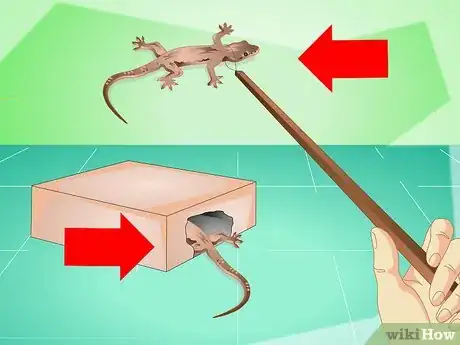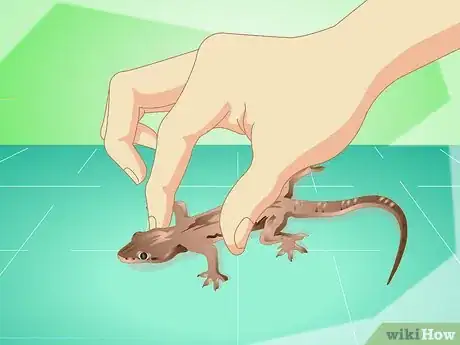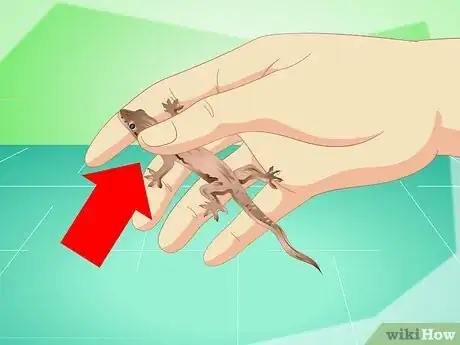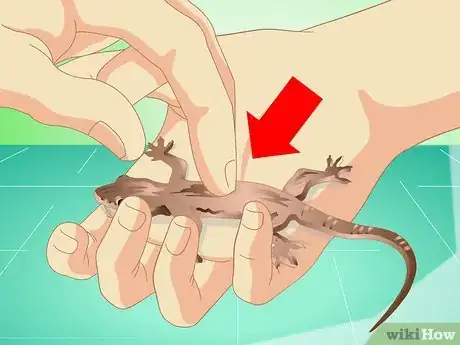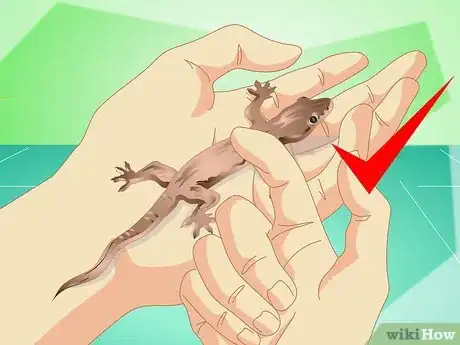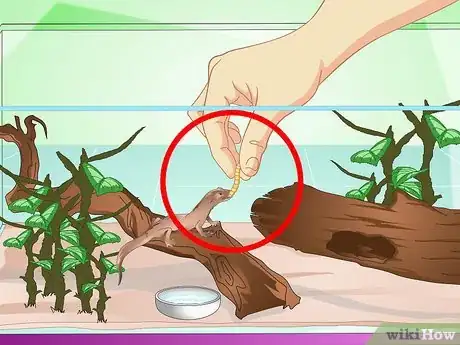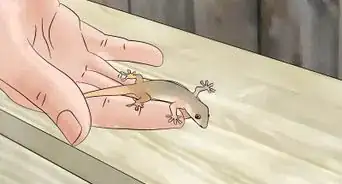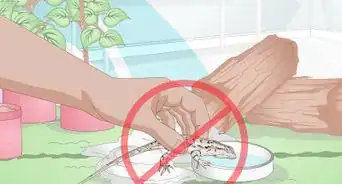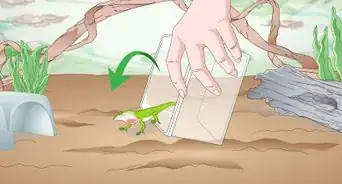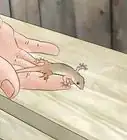This article was co-authored by Pippa Elliott, MRCVS. Dr. Elliott, BVMS, MRCVS is a veterinarian with over 30 years of experience in veterinary surgery and companion animal practice. She graduated from the University of Glasgow in 1987 with a degree in veterinary medicine and surgery. She has worked at the same animal clinic in her hometown for over 20 years.
There are 7 references cited in this article, which can be found at the bottom of the page.
wikiHow marks an article as reader-approved once it receives enough positive feedback. This article received 13 testimonials and 86% of readers who voted found it helpful, earning it our reader-approved status.
This article has been viewed 306,223 times.
Would you like to keep a house lizard as a pet? Lizards can make great pets because they are “low-maintenance.” They are quiet, not very messy, and do not need a lot of attention or space.[1] However, make sure that you do not try to catch a wild lizard and keep it as a pet. Capturing a wild lizard will cause the lizard to feel stressed and it may die as a result.[2]
Steps
Preparing a Home for Your New Pet
-
1Get a glass aquarium and add a screen top. A 24 by 12 by 12 inches (61 by 30 by 30 cm) or larger tank is recommended. Make sure you seal any openings where your lizard could escape from.[3]
-
2Use a UVB light or a heating pad set on low to warm your pet’s new home to the appropriate temperatures. Lizards are cold-blooded creatures that rely on outside warmth to function. The tank should be a minimum of 80 °F (27 °C) at one end with a basking area with a temperature of about 95 °F (35 °C).[4]
- Do not use heated rocks because they can cause your lizard to overheat.
Advertisement -
3Choose a flooring that is easy to clean. Paper towels and newspapers are inexpensive options that work well for smaller and medium-sized lizards and are easy to change. If you want to breed your lizard, add about half-inch soil mixed with sand. Maintain proper temperature. You should also know what sex is your gecko (male or female).
-
4Create visual barriers with vining plants, smaller branches, pieces of bark or hide boxes. Your lizard likes to defend itself by hiding.[5]
Catching a Common House Lizard
-
1Locate an area near your home where you see lizards regularly. Lizards like warmth and sunlight, so look for sunny outdoor spots.
-
2Capture a lizard by either setting a trap or using a lizard fishing pole.
- Setting a trap: Find an odorless box, cover it with plastic wrap and cut a slit. Place the box in a location where you have seen lizards and add live insect bait. Check the trap two or three times a day. It may take several days to catch the lizard, so make sure replace the bait as necessary.
- Using a lizard fishing pole: Source a stick that is at least 3 feet (0.91 m) and a long piece of dental floss. Tie the dental floss to one end of the stick. Make a slip knot out of the other end with a loop large enough to fit around a lizard’s neck. Approach the lizard of your choice slowly and gently fit the loop around its neck. The best time to catch lizards is early in the day because they have not had a chance to warm up and will move more slowly.
-
3Identify your new lizard using a resource such as Animal World. Geckos, anoles, and skinks are common types of lizards that can make good pets.
Handling Your New Lizard
-
1Handle your new pet carefully. Lizards, like any other animal, can feel pain. Some signs that your lizard is feeling uncomfortable include biting, thrashing around, clawing, and scrambling.[6]
-
2Scoop up your lizard in your hand and hold its head delicately between your thumb and forefinger.
- Alternatively, clasp it in your hand while grasping one of its front legs between your thumb and forefinger. With this method, your lizard is likely to struggle and may bite you.[7]
-
3Place one hand gently over the back of your lizard. Use your other hand to grasp your lizard around its sides with just enough pressure to hold it still.
-
4Make sure to support the lizard’s body weight and length and allow them to become comfortable. Be calm and make smooth motions.[8]
Caring For Your New Lizard
-
1Provide water for your lizard daily. Depending on the type of lizard, a shallow container of water, a bubbler bowl (for lizards who do not drink still water), or misting the walls of the cage daily will work (for arboreal and desert lizards) as water sources.[9]
-
2Purchase insects such as live crickets or super mealworms and wax mealworms larvae from the pet store to feed your lizard 5 to 7 times a week. Make sure to buy insects of the appropriate size for your lizard.[10]
- Start with 6 insects to see how many your pet will eat. "Leftover" food can be dangerous to your lizard while it is asleep, so it is important to not put too many insects into the tank.
-
3Clean the tank whenever it smells musty or you see animal waste.
- Remove the flooring. If it is paper, discard the original and replace with new paper towels or newspaper. If it is gravel or carpet, wash the existing flooring and set back into the cage.
- Mist the cage with cleaner. A good cleaner is a mixture that is one part alcohol and two parts water with a drop or two of dishwashing liquid. Wipe the cage dry.[11]
Warnings
- Get your lizard's neck out of the strings of the pole as fast as possible or it could struggle and choke itself.⧼thumbs_response⧽
- Make sure you take proper precautions when handling your new pet. Your lizard, like all animals, may carry diseases and can cause infections.[12]⧼thumbs_response⧽
- Keep in mind that by capturing a house lizard, you're isolating it from other lizards. If you're passionate about keeping a thriving lizard population in your area, hold off on catching it. Try taking a picture or pausing for a moment to admire it instead.[13]⧼thumbs_response⧽
References
- ↑ http://www.reptilesmagazine.com/Reptile-Care-For-Beginners/Best-Pet-Reptiles-For-Children/
- ↑ https://www.zillarules.com/articles/5-reasons-you-should-not-take-home-wild-reptiles
- ↑ http://www.petplace.com/article/reptiles/general/housing-caging-your-reptile/housing-your-lizard
- ↑ http://www.petplace.com/article/reptiles/general/housing-caging-your-reptile/housing-your-lizard
- ↑ http://www.petplace.com/article/reptiles/general/housing-caging-your-reptile/housing-your-lizard
- ↑ http://www.anapsid.org/handlingreptiles.html
- ↑ http://www.petplace.com/article/reptiles/general/enjoying-your-reptile/how-to-handle-a-lizard
- ↑ http://www.anapsid.org/handlingreptiles.html
- ↑ http://www.petplace.com/article/reptiles/general/housing-caging-your-reptile/housing-your-lizard
- ↑ http://www.petplace.com/article/reptiles/general/feeding-nutrition-of-reptiles/feeding-your-lizard
- ↑ http://www.petplace.com/article/reptiles/general/housing-caging-your-reptile/housing-your-lizard
- ↑ http://www.cdc.gov/features/salmonellafrogturtle/
- ↑ https://www.zillarules.com/articles/5-reasons-you-should-not-take-home-wild-reptiles
About This Article
To catch a common house lizard and keep it as a pet, start by cutting a slit in a box covered with plastic wrap and putting live insects inside the box to act as bait. Next, place the box in a warm, sunny spot near your house where you regularly see lizards, and check the trap 2-3 times a day. When you catch a lizard, scoop it up gently with its head between your thumb and pointer finger, then put it in a tank with a good supply of water. Additionally, feed it live insects or mealworm larvae from your local pet store 5-7 times a week. For more tips from our Veterinary co-author, including how to set up a tank for your lizard, keep reading!
